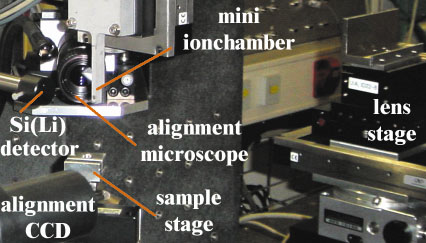- Home
- Users & Science
- Scientific Documentation
- ESRF Highlights
- ESRF Highlights 2001
- Micro-analysis and Imaging
- ID18F: A New X-ray Microprobe End-station
ID18F: A New X-ray Microprobe End-station
A new User end-station, ID18F (Figure 140), dedicated to precise and reproducible X-ray microprobe measurements, has been constructed in the third experimental hutch of the ID18F beamline in collaboration with the MiTAC laboratory of the University of Antwerp, Belgium. The activities are also funded through the EU Project (Growth Programme), MicroXRF.
 |
Fig. 140: Experimental setup of ID18F. |
The goal of the end-station is to improve procedures of micro-X-ray fluorescence analysis in order to reach 5-10% average accuracy of quantification down to sub-ppm concentration levels for elements of Z > 13. In order to achieve this goal, high reproducibility of the measurement geometry and instrumental parameters, and very good short and long-term stability and precise monitoring (< 1%) of the intensity variation of the incoming beam, are required.
The end-station uses the optics infrastructure of the ID18 beamline: the energy of the monochromatic radiation can be tuned in the 6-28 keV range by changing the undulator gap and employing a fixed-exit double crystal Si(111) monochromator.
The micro-probe setup is positioned on a movable granite table. Compound refractive lenses are used for focusing. The routinely achievable spot size is 1-2 micrometres vertically and 12-15 micrometres horizontally. Ionisation chambers and photodiodes monitor the intensities of the incoming, focused and transmitted beam. A miniature ionisation chamber with an aperture of 50 micrometres in diameter as an entrance window was developed at the ESRF (M. Kocsis, J. Surr) for measuring the intensity of the focused beam close (< 5 cm) to the sample. The 3-5 % precision available by using the measured signal of the mini-ionisation chamber for normalisation purposes will be improved further in the future.
Characteristic X-ray line intensities are detected by a Si(Li) detector (GRESHAM) of 30 mm2 active area, 3.5 mm active thickness and 8 micrometre thick Be window placed in 90° geometry to the incoming linearly polarised X-ray beam. Fast scanning XRF measurements (> 0.1 s live time/spectrum) are possible. The AXIL software package is used for the on-line evaluation of X-ray fluorescence spectra. Quantification of scanning micro X-ray fluorescence experiments with inverse Monte Carlo simulation is under development.
The analytical characteristics (degree of polarisation, absolute and relative limits of detection) of ID18F were determined by measuring certified reference materials. The degree of polarisation is > 95%. The available relative detection limits (DL) are < 0.1 ppm for elements of Z > 25. DLs down to a few ppb are possible for a number of elements on the basis of 1000 s time measurements and that of ppm is available during several seconds. The absolute DLs are less than 1 fg for elements of Z > 25. The flux in the focused beam is 109-1010 photons/s depending on the energy of the incoming beam.
Principal Publication and Authors
A. Somogyi (a), M. Drakopoulos (b), L. Vincze (a), B. Vekemans (a), C. Camerani (c), K. Janssens (b), A. Snigirev (b) and F. Adams (a), X-ray Spectrom, 30, 242, (2001).
(a) MiTAC, University of Antwerp, Wilrijk (Belgium)
(b) ESRF
(c) Chalmers Univ. of Technology, Göteborg (Sweden)



